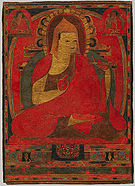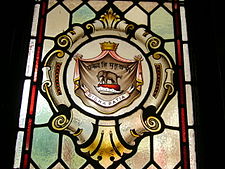- Dighapatia Raj
-
Armorial of Dighapatia RajCountry East Bengal Founder Raja Dayaram Roy Current head Legally Abolished (1950) Founding 1700s Dighapatia Raj (sometimes called Dighapatia Raj Paribar literally Dighapatia Royal Family[1]) was a zamindari in present day Rajshahi, which was ruled by this dynasty of 7 generations of Rajas from late seventeenth century till the mid-twentieth century; when the democratic government took power after the end of the British Monarchy’s rule in India, in 1950, the East Pakistan government abolished aristocracies and the zamindari system in present day Bangladesh. The family was seated at the Dighapatia Palace.
The family contributed largely to the development in education, infrastructure and culture of Rajshahi and North Bengal. They were especially famous for their generosity and public spirit. The Rajas built the Varendra Research Museum [2] among other institutions of culture and education. The rajas of Dighapatia were seated at the Dighapatia Palace[3]. They received royal titles and titles of honor from the British Crown such as Raja, Maharaja and Raja Bahadur[4].
Contents
History
Part of a series on the History of Bengal 
Ancient Bengal Vedic Period Ancient Bengali States
Gangaridai Kingdom, Vanga Kingdom,
Pundra Kingdom, Suhma Kingdom,
Anga Kingdom, Harikela KingdomMauryan Period Classical Bengal The Classical Age Shashanka Age of Empires
Pala Empire, Sena EmpireMedieval Bengal Arrival of Islam
Sultanate of Bengal, Deva Kingdom
Bakhtiyar Khilji, Raja GaneshaMughal Period
Pratap Aditya, Raja Sitaram Ray
Nawab of Bengal, Baro-BhuyansModern Bengal Company Raj
Zamindari system, Bengal famine of 1770British Indian Empire
Bengal Renaissance
Brahmo Samaj
Swami Vivekananda, Jagadish Chandra Bose,
Rabindranath Tagore, Subhash Chandra BosePost-Colonial
1947 Partition of Bengal, Bangladesh Liberation War
Sheikh Mujibur Rahman, Jyoti BasuSee Also Bangladesh, West Bengal The first Raja was Dayaram Roy who, at a very young age, received the help from Raja Ramjivan Roy, the first Raja of Natore Raj family, and eventually became his dewan. Raja Dayaram led the army of Raja Ramjivan in aid of the Nawab of Bengal in 1716 and overthrew the rebellious Raja Sitaram Ray, who was a zamindar(and later king, raja) of neighboring Bhusna state. The sack of Muhammadpur, Raja Sitaram's capital, later enabled him to ultimately lay the foundation of the Dighapatia dynasty. For his loyalty, he received large tracts of land in Rajshahi and Jessore as grants and later acquired zamindari in Bogra and Mymensingh.
Nawab Murshid Quli Khan, who was the nawab of Bengal under Emperor Aurangzeb conferred on him the title of 'Rai-Raiyan' in recognition of his services. When the Earl Cornwallis introduced the Permanent Settlement Act, a large number of the old feudal lords and zamindars created during the time of the Nawab Murshid Quli Khan could not meet land revenue standards and thus became defaulters. Their estates were sold up to a new class of wealthy lords. The Dighapatia Raj was one of the few remnants of the old decaying 'jagirdars'. They were avidly following European dress, wine, horse race and various such other external glamour of life. The princely western influence is reflected not only in their palace architecture but also in their furniture and other interior decorations. However, during certain ceremonial occasions they donned extravagant robes, jeweled turbans and carried priceless inlaid swords in dainty scabbard tucked at theirs waists, following the bygone fashions of the Mughal nobility even when the Mughal dynasty and their imperial rule had faded. Pran Nath Roy and Pramada Nath Roy were some of the important zamindars of Dighapatia.[5].
Family of Rulers
Dayaram Roy
Dayarampur is named after him, HQ of Army Engineers
Ananda Nath Roy
Chandra Nath Roy
Promodo Nath Roy
Sarat Kumar Roy
Protibanath Roy
Architecture
Uttara Gano Bhaban also known as The Maharaja's Palace or Dighapatia Palace (or Rajbari) is a historic, formerly royal palace in Natore, Bangladesh. It was built by the Raja of Dighapatia but is used as the official residence of the heads of states of Bangladesh in North Bengal. In the north, it serves as an official Presidential Palace. Various historic meetings took place at the palace,[6] during the British Raj, East Pakistan era and finally after the independence of Bangladesh.
History
Originally used as the residence of the Rajas of Dighapatia, it is located about 2.40 km away from the Natore town. Raja Dayaram Roy constructed the main structure of the palace along with a few wings; but it was Raja Pramada Nath Roy rebuilt the whole palace complex after the catastrophic earthquake of 1897.
The Dighapatia Palace was made 'Dighapatia Governor House' on July 24, 1967 by Abdul Monem Khan, the Governor of erstwhile East Pakistan. Later, after the country's independence, Bangabandhu Sheikh Mujibur Rahman, President of Bangladesh declared the Dighapatia Governor House as Uttara Gonobhaban on February 9, 1972. Before the split of Pakistan and Bangladesh, President Ayub Khan resided at the Palace.[7]
Architecture
The palace area occupies around 43 acres (170,000 m2) of land or around 25 bighas, enclosed within a moat and a high perimeter wall. The estate also contains few lakes and greenery. The front gate entrance houses an imposing four-storied pyramidal gateway with a clock tower. It is also contains a series of arched openings on three storeys and two circlets flanking the clock on the top storey.
The 'E' shaped east facing facade is over a 100 ft (30 m) long and has a prominently protruding porch in the center. In addition, two slightly projecting wings exist on both ends. The facade is decorated with floral designs in its plasterwork. A series of pointed trefoil arched openings provide access to the building across a running balcony in front. The parapet on the roof is decorated with merlons. The hemispherical dome with a sharp finial atop covers the central foyer.
The palace block houses nine sleeping chambers, a durbar hall, a dining hall and a danceroom. The ceiling of the durbar hall is over 25 feet (7.6 m) from the floor and is much higher than the flanking apartments. The ceiling is decorated with painted floral motif in wood set in bays. Although the palace ground was plundered in various times in history, there are still some beautiful pieces of relics such as the neo-classical bronze Greek statues, flower vases, chandeliers, carved wooden bedstead and princely furniture. The main foyer also displays two armoured knights.
The southern wing of the palace is similarly designed in the shape of an 'E'. There is a large garden in the front with a fountain and a few life-size marble female sculptures located at the four corner porticoes. A broad verandah in front leads to a large foyer and beyond, to a series of apartments. The roof of the verandah is carried on semi-Corinthian columns alternated by trefoil arches. A rear verandah on the western end of the block overlooks a part of the moat. The bathroom is made entirely of marble.[8]
The 'Kumar Palace' (literally Prince's Palace) located to the southeast, close to the main palace compound is a two-storeyed building that houses four main bedrooms and a dressing room on the upper floor and a series of apartments on the ground floor. The small treasury hall stands directly behind the Kumar Palace. There also exists the single storeyed 'Rani Mahal' (Queen's Palace) to the south of the main palace block, originally occupied the vast fortified area of the palace. The guesthouse, stables, the servants quarters etc. have all disappeared with time and at the aftermath of the earthquake of 1897.[9]
See also
References
- ^ Rajshahi University History
- ^ Encyclopedia Article "Varendra Research Society"
- ^ Encyclopedia Article "Dighapatia Palace" Nazimuddin Ahmed
- ^ Bangladesh Encyclopedia "Article on the Dighapatia Raj Bangladesh District Gazetteer, Rajshahi, Dhaka,1976
- ^ Bangladesh Encyclopedia "Article on the Dighapatia Raj Bangladesh District Gazetteer, Rajshahi, Dhaka,1976
- ^ The Historic Uttara Gonobhavan "The Daily Star" September 1, 2008
- ^ Former Presidential Palace Neglected "Probe News" Anwarul Quadir
- ^ Natore Uttara Gonobhaban " Beautiful Bangladesh"
- ^ Banglapedia: The Bangladesh Encyclopedia "Dighapatia Palace"
Categories:- Natore District
- Official residences in Bangladesh
- Prime ministerial residences
- Dynasties of India
- History of Bengal
Wikimedia Foundation. 2010.






